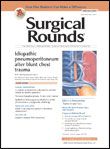Recovery Trajectories for Short-stay Surgery Vary Considerably
Though hospital stay duration was once used as a surrogate outcome for surgical recovery, the increasing popularity of short-stay surgery has eliminated that measure, making it harder for hospitals to track recovery trajectories and more difficult for surgeons to plan physical, psychological, and social postoperative courses for prospective patients.

Though hospital stay duration was once used as a surrogate outcome for surgical recovery, the increasing popularity of short-stay surgery has eliminated that measure, making it harder for hospitals to track recovery trajectories and more difficult for surgeons to plan physical, psychological, and social postoperative courses for prospective patients.
In a study that appeared in the July 2014 issue of Surgery, researchers from the Montreal General Hospital in Quebec, Canada, examined recovery trajectories for short-stay surgeries, focusing on physical activity and health-related quality of life (HRQOL), as well as isolated predictors of prolonged, post-discharge recovery.
Using validated questionnaires to assess physical activity, expended calories, and HRQOL, the study authors preoperatively and postoperatively evaluated 132 patients who underwent short-stay abdominal surgery. According to the researchers, a majority of the participants were male, and the mean age was 53 years old.
More than 90% of the patients were discharged on the day of their surgery, while the remaining participants were discharged within 24 hours. In terms of procedures, 40% of the patients underwent open inguinal herniorrhaphy, 30% had laparoscopic cholecystectomy, and the rest were divided among 15 other operations.
Three weeks after their short-stay surgeries, half of the patients reported activity below their preoperative levels. Of that group, patients who were older, had a complication, and reported either low baseline physical HRQOL or high baseline physical activity were less likely to attain preoperative levels of physical activity at 3 weeks.
At 2 months post-surgery, one-third of the patients remained below preoperative measures of physical activity and physical HRQOL, and only high baseline physical activity was an
important predictor of prolonged recovery. However, social, emotional, and mental HRQOL tended to recover quickly, as most of the patients were at or close to preoperative levels 3 weeks after surgery and above baseline levels at 2 months.
Although the authors concluded that recovery trajectories for same-day surgery vary considerably, they noted that the variables can help surgeons more accurately counsel their short-stay candidates on what to expect while they heal.
